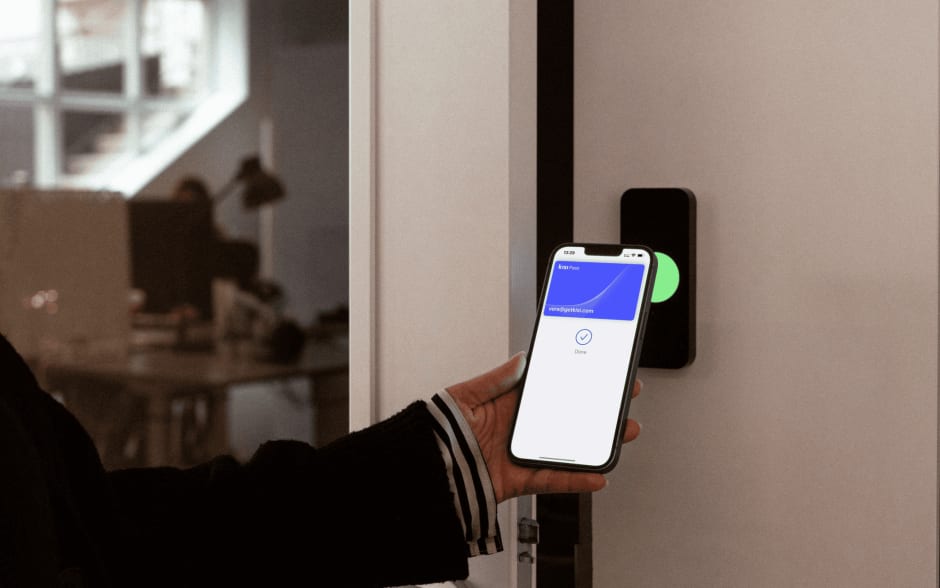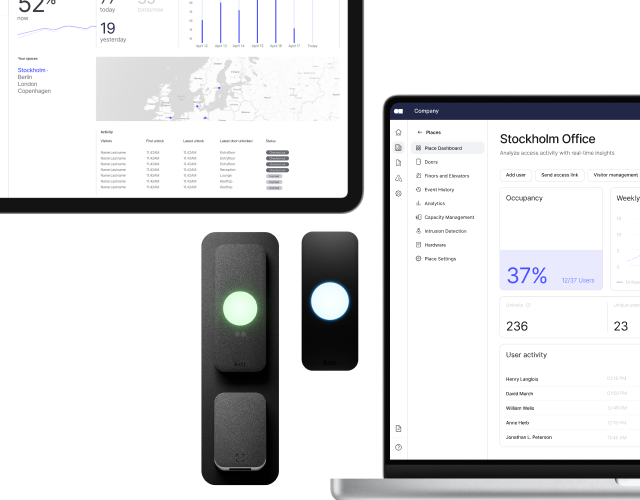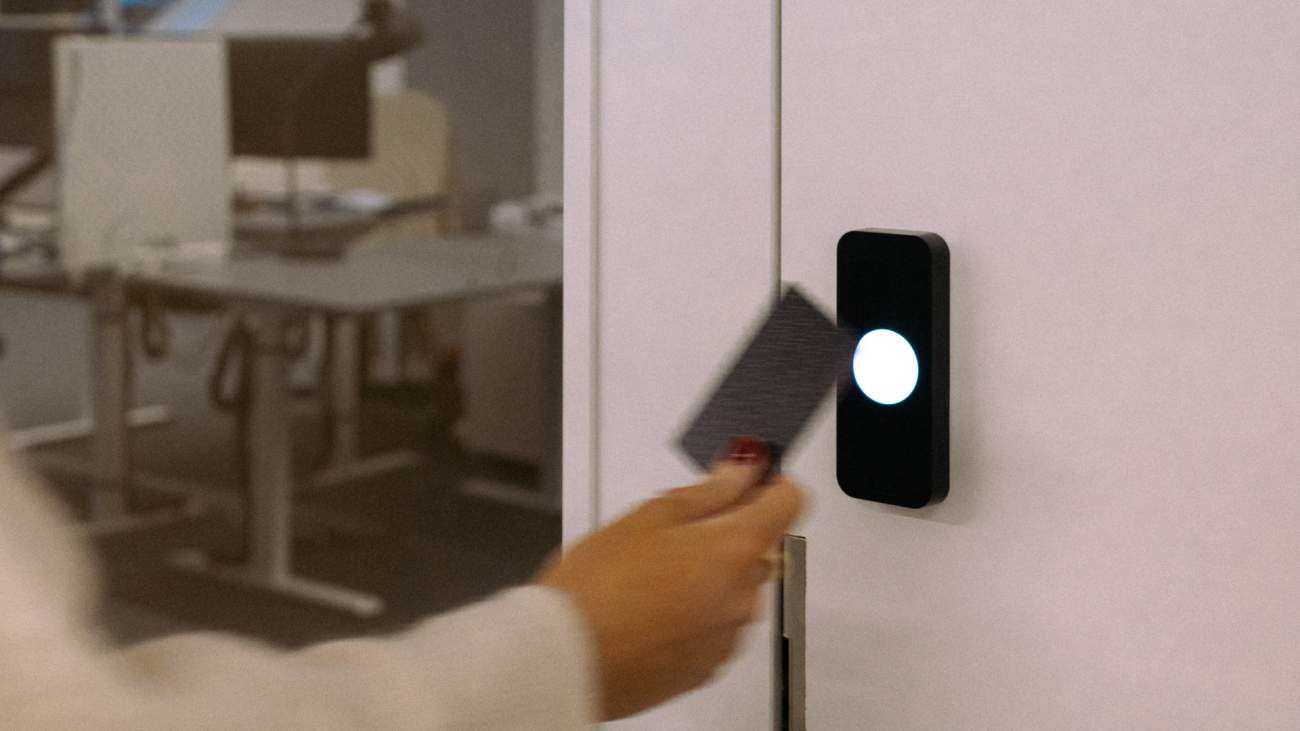Badge readers are a popular access control component because they manage to address both security and ease of use. This guide will explain how badge readers work, why many businesses use them, and what you should look for when purchasing them.
What are badge readers? #
Badge readers—like the Kisi Reader Pro—are devices that can scan a person’s credentials, communicate with the access controller to grant or deny access, and record data. Many companies use them for fast and easy access control. In addition, some companies use modern badge readers for employee clock-ins, emergency roll calls, and mobile device management.
How badge readers work #
To use a badge reader, an employee presents their badge by holding it in front of or near the device. The reader scans the data on the badge, communicates it to the control panel (also known as the access controller), and compares it to information in a database. If the employee has access authorization, the panel triggers the door to unlock so the employee can enter the space. When the system detects that an employee is not listed as authorized in the database, the door remains locked.

NFC vs RFID readers #
Badge readers generally rely on one of two underlying technologies: Near-field communication (NFC) and radio frequency identification (RFID).
NFC is a short-range wireless technology that enables devices to exchange information. When a badge reader uses NFC, the employee has to hold their badge in close proximity so that it can read the encoded information and verify their identity.
RFID is also another wireless system that uses radio waves, but it has a much larger range. Businesses with RFID readers issue badges that contain RFID tags containing their identifying information. Because it can detect the presence of a tag over a long distance, employees do not have to hold their cards directly in front of the reader.
Differences between badge readers and other solutions #
Badge readers are one of many options available to businesses that want to implement access control. Some organizations opt for keypads, which require users to enter codes rather than use cards or badges to gain access. Although keypads are simple and straightforward, they can also create security risks. Would-be intruders can obtain a code by stealing or soliciting information from an authorized employee.
Another common access control technology is a biometric reader. Unlike proximity door readers that use cards or tags, these readers grant access based on a person’s physical characteristics, such as a fingerprint or facial scan. Biometrics have strong security, but these readers are often more expensive than badge readers.
Some modern badge readers, like the Kisi Reader Pro, don’t require the well-known plastic badge. By installing a mobile app, the user uses their phone as the badge, eliminating the need to keep track of physical badges and decreasing the risk of lost or misplaced badges. The latest access development enables users to keep their badges in Apple Wallet for an additional layer of convenience and security.

Badge reader applications #
Badge readers are a practical solution for a wide range of industries. They’re particularly valuable for buildings that contain sensitive data, expensive inventory and equipment, and vulnerable populations like children. Some of the organizations that can benefit most from using badge readers include:
- Healthcare facilities
- Coworking spaces
- Gyms, fitness, and wellness centers
- Law offices
- Office suites
- Schools and daycares
- Manufacturing facilities
Along with placing badge readers at primary entrances, organizations can also install them on interior doors to prevent guests, contractors, clients, and customers from entering employee-only spaces. If your business has different levels of authorization based on employee roles, you can also use badge readers to limit access to high-security areas.
Advantages and challenges of using badge readers #
Badge readers are an effective security solution for many organizations, but they also come with drawbacks. Understanding both their positives and negatives will help you make a more informed decision about whether it’s the answer to your access control concerns.
Reasons to use badge readers #
Businesses all over the world trust badge readers to keep their spaces secure and their employees safe. These are some of the most compelling arguments in favor of this kind of technology:
- Better security: Badge readers are significantly more secure compared to many other access methods, including physical keys and keypads. Their presence can prevent unauthorized entries and deter potential intruders.
- Contactless access: The COVID-19 pandemic underscored the importance of hygienic, hands-free access methods. Unlike keypads, which require employees to make physical contact to unlock the door, badge readers can scan users’ credentials from a distance.
- Streamlined business operations: Easily admitting employees, guests, and other people to your business allows you to operate more efficiently. Security teams can also focus their efforts on more pressing issues when they don’t have to spend time unlocking and opening doors.
- Durability: High-quality badge readers are designed to withstand wear, tear, and weather conditions such as rain, sun, and ice. Because employees don’t have to insert a physical item like a key into the lock, the door is also less likely to jam or stick.
- Greater insights: Knowing who is on-site at your business at any given moment can give you a deeper understanding of your business’s strengths, weaknesses, and potential for growth. Some badge readers, including Kisi, provide this type of data.
Although many badge readers offer all these benefits and more, a lot can differ from one provider and product to the next. Examining specific features and functionalities is vital if you want to get the most value out of your reader.

Potential problems with badge readers #
Despite all their upsides, badge readers can also create issues for organizations, particularly if they don’t have support from a knowledgeable access control expert. One of the primary concerns for many businesses is the detection radius. Some companies are unsure what kind of range they need their reader to offer, and choosing the wrong solution could lead to an uptick in issues such as tailgating.
Hackers might also attempt to target your readers, recognizing them as an opportunity to gain physical access to your building. To lower that risk, look for a system with encryption and other advanced security features.
Another issue that might complicate your access control is electricity outages. If the power fails and your badge readers are no longer functioning, how will your employees get into the building? Fortunately, some systems like Kisi have workarounds that allow you to continue using a door when the power goes out.
Understanding the cost of badge readers #
Budget is a top priority for many organizations looking to enhance their access control. The price of badge readers differs based on the design and features. They typically range from $80-$1,200, but if you don't already have an access control system in place, the price goes beyond the reader itself. You may also pay for infrastructure changes, hardware, and software, bringing the badge access control system cost around $3,350 USD.
After the initial investment, you may also have to keep funds aside for occasional maintenance or upkeep of issuing credentials unless you decide on digital badges. You can also achieve significantly lower costs in multiple areas of your business. Badge readers often have direct cost savings because they lower the risk of theft and property damage, which equates to decreased losses and lower operational costs.
In addition, you may also see substantial indirect costs. For instance, a badge reader that creates a safe work environment can help improve productivity. Employees don't lose time searching for keys or opening doors for their colleagues and guests, and fewer interruptions and distractions equate to higher profitability. They also know that you care about their safety and well-being, which can increase employee morale.

How to choose the right badge reader #
The access control reader market is rapidly expanding, with experts projecting it will reach a value of $9.33 billion by 2030, up from $4.22 billion in 2023. That type of growth is positive in that it means you have many providers and solutions to choose from. The bad news is that you have to sift through more options to find the right reader for your business.
Here are some essential criteria to consider when you look at different badge readers:
- Convenience: Your badge reader should alleviate stress for both you and your employees. A solution like Kisi, which allows you to use physical and digital employee badges, gives you greater flexibility in the types of access methods that you can choose for your employees.
- Data collection: Badge readers can gather useful information about building occupancy, attendance, security, and space utilization. Look for a reader that collects robust data that you can analyze to optimize your operations.
- Management app: The access management software is vital to making the most out of the badge reader. Modern cloud-based badge systems enable remote assigning and designing badges or access privileges to efficiently manage all users, places, and doors from a single dashboard.
- Compatibility: Integrating badge readers with your existing systems and hardware allows you to streamline and strengthen your building security. Find a solution that you can also connect to other aspects of your security system, such as video surveillance.
- Installation: Some badge readers are more difficult to install than others. Review the installation requirements and research the cost of a professional installer before committing to a solution.
- Adaptability: As technology and your business continue to evolve, you’ll need a badge reader that can keep up with the times. Future-proof solutions are easy to scale and can incorporate new types of credentials as they become available.
In addition to looking at these aspects of a badge reader, it’s also worthwhile to look for a provider that’s willing to work with you to address your business’s unique needs.

Badge reader installation and set-up guide #
When positioning your reader, choose an unobstructed location that isn’t behind glass or aluminum. Some mobile credentials may not work to their full potential if readers are placed behind these kinds of materials, particularly if they’re tinted.
Once you’ve selected a spot for the reader, you’ll follow these basic steps:
- Attach your reader to the mounting frame and bracket.
- Connect the reader to the cabling.
- Insert the reader inside the mounting frame
- Wire the reader using a CAT6 Ethernet cable.
- Test the reader to confirm it’s working correctly, both before and after splicing the Ethernet cable.
After you’ve completed this process, you can configure your reader by assigning it to a particular place and door. When using Kisi you can also set reader permissions with settings such as two-factor authentication, MotionSense, held open buzzer, and tamper protection. You might also choose to adjust the sensitivity.
Make access easier with Kisi badge readers #
Thousands of companies use Kisi’s badge access solution to secure their spaces and protect their assets. Explore the Kisi Reader Pro 2 and Terminal Pro to see how modern access control readers provide a seamless experience for businesses, employees, and guests alike. Even better, request a demo to see how our scalable badge access door system can work with your space, whether you’re upgrading your existing system or starting from scratch.


